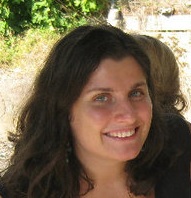Anna Engelsone
Computer Science and Applied Mathematics major
German minor
Class of 2001

(1/31/2014) I came to Goshen College as a 17-year-old international student with only a vague idea of what I wanted to do when I grew up. Two things at GC had a profound influence on my career path: a mentoring relationship with professor David Housman, who encouraged me to get involved in undergraduate math research and apply to graduate school, and DevCorp, which provided real world IT job experience and a chance to develop the programming and database skills that I still use in my work on a daily basis.
My favorite courses at GC included the Calculus sequence with Merritt Gardner, Computational Theory with David Housman, Data Structures and Algorithms with Floyd Saner, and Mathematical Physics with Carl Helrich.
After graduating with a degree in Computer Science and Applied Mathematics and a minor in German, I went on to a PhD program in Operations Research at North Carolina State University. Operations Research is an interdisciplinary program that combines hands-on courses in Engineering and Computer Science with the more theoretical coursework offered by the Math Department.
Linear Programming was among the courses I found most useful in my work later on, and Dynamic Programming was among the most enjoyable. A joint research project with Boeing allowed me to apply what I was learning in Differential Equations and Optimal Control to improving algorithms used to compute spacecraft trajectories.
Traveling to conferences to present our research, I met young mathematicians from around the world. Many of them went on to rewarding careers in academia: teaching college students and doing in-depth research on theoretical as well as applied topics. Others are doing very interesting and vitally important work in government. Government agencies from Department of Defense and NSA, to the IRS and the Census Bureau employ a large number of mathematicians. But I was eager to put what I was learning to immediate practical use and a little wary of jobs that required high-level security clearance, so I decided to join the private industry.
My first job out of graduate school was with a small, dynamic consulting firm. It taught me to think fast on my feet and exposed me to the kind of optimization problems that arise in the world of transportation. Clients would come to us asking whether adding new cargo ships to their fleet would be profitable in the log run, or whether they should reroute their planes through a different airport hub, and we had to quickly build a mathematical model that reflected their problem and analyze its behavior under several different scenarios.
My second and current job is with a large software company which develops applications to help retail chains predict future demand in their stores and optimize their prices. The pace isn’t as fast and the hours are flexible, which allows me to spend more time with family and friends. Instead of focusing on the needs of one client, we try to develop systems that are easy for non-mathematicians to use and that can deliver good results under many different conditions. A big part of my job is coming up with new algorithms, giving presentations about them to clients and colleagues and writing code. But an even bigger part involves analyzing huge, messy data sets — the raw historical sales data we get from clients, and the results of applying various algorithms to it. I often wish I had taken more courses in Statistics, or paid more attention in the ones I did take.

My daughter Liz, who is about to turn 12, does quite well in math (whether exposure to Differential Equations lectures in utero had anything to do with this is anyone’s guess) and my partner Daniel is also an IT professional. We all have hobbies that we are passionate about: Liz builds sets for school theater productions, Dan plays acoustic guitar, and I create supertitles and image projections for a local opera company.




